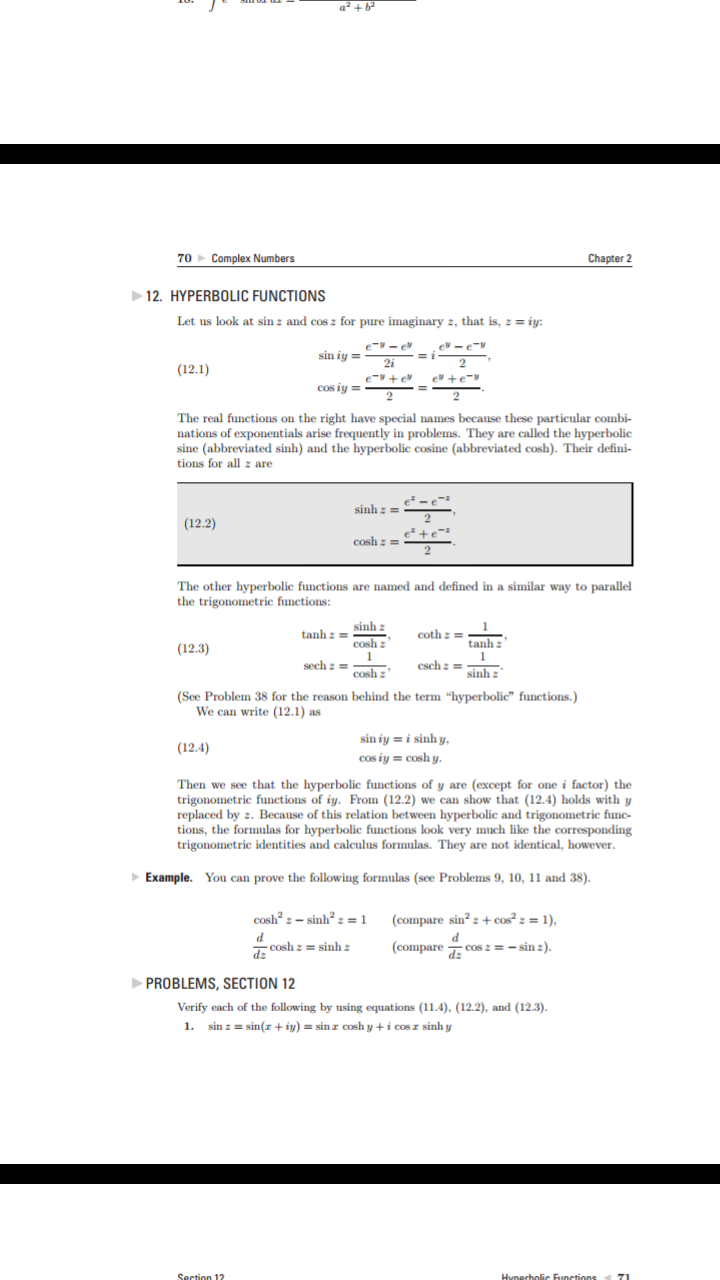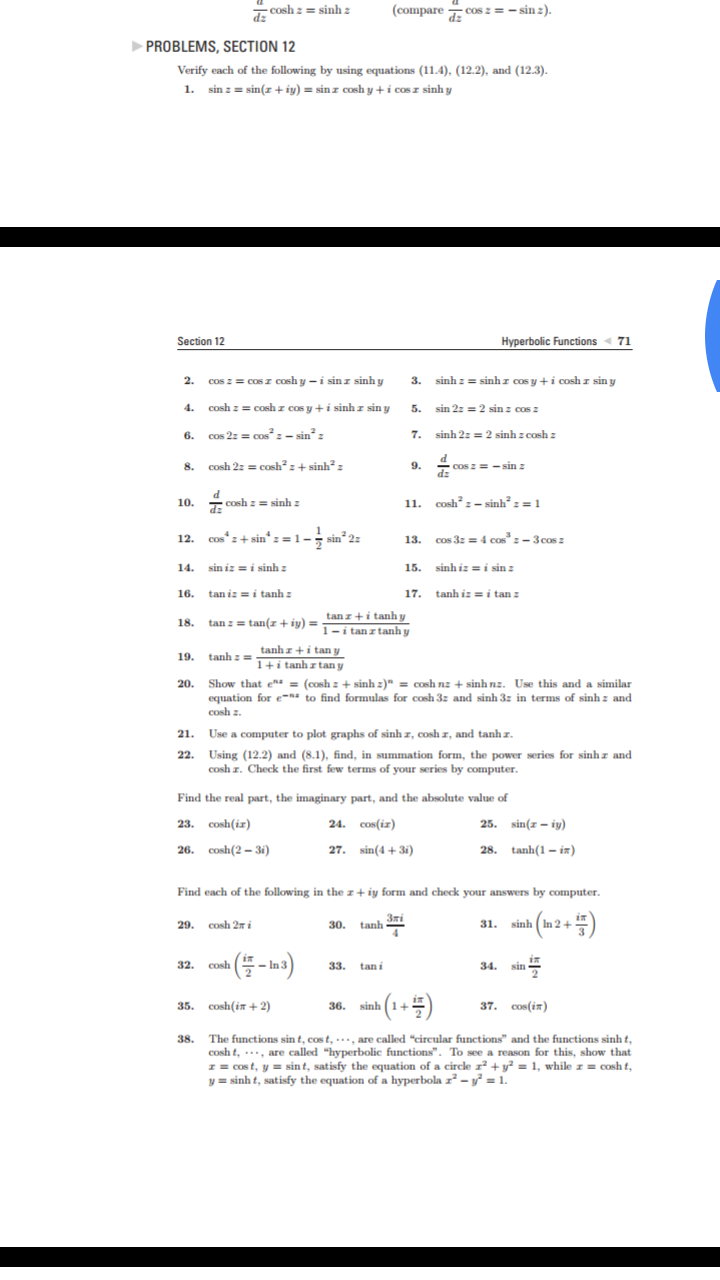a+ b 70 Complex Numbers Chapter 2 12. HYPERBOLIC FUNCTIONS Let us look at sinz and cos z for pure imaginary z, that is, z=iy: e-e e-e sin iy= 2i (12.1) e e e e COs iy 2 The real functions on the right have special names because these particular combi- nations of exponentials arise frequently in problems. They are called the hyperbolic sine (abbreviated sinh) and the hyperbolic cosine (abbreviated cosh). Their defini- tions for all z are e-e sinhz (12.2) Cosh z = +e The other hyperbolic functions are named and defined in a similar way to parallel the trigonometric functions: sinh z cosh coth tanh z tanh (12.3) 1 csehz=sinhz' sech:cosh (See Problem 38 for the reason behind the term "hyperbolic" functions.) We can write (12.1) as sin iy i sinh y, cos iy cosh y. (12.4) Then we see that the hyperbolic functions of y are (except for one i factor) the trigonometric functions of iy. From (12.2) we can show that (12.4) holds with y replaced by . Because of this relation between hyperbolic and trigonometric func tions, the formulas for hyperbolic functions look very much like the corresponding trigonometric identities and calculus formulas. They are not identical, however. Example. You can prove the following formulas (see Problems 9, 10, 11 and 38). cOsh2-sinh + cos? z = 1), 1 (compare sin2 d cosh zsinh z (compare cos z=-sinz). dz PROBLEMS, SECTION 12 Verify each of the following by using equations (11.4), (12.2), and (12.3). sin zsin(z+iy)=sinz cosh y+ i cosr sinh y 1. Section 12 71 Hynerholic Functions (comparecos z = - sin z). COsh zsinh z COs PROBLEMS, SECTION 12 Verify each of the following by using equations (11.4), (12.2), and (12.3) 1. sin zsin(z+iy) = sinz cosh y + i cosr sinh y Hyperbolic Functions 71 Section 12 cos zcosr cosh y - i sinz sinh y sinhz=sinhz cos y+i cosh z sin y 2. 3. cosh zcoshr cos yi sinhz sin y 4 sin 2z=2 sin z cos 5. COs 2 $+/ sinh 2z 2 sinh z cosh z cos 2zcos :- sin2 z 7. 6. cosh 2zcosh2 z + sinh2 z 9. COs z=sin z dz 8. d 10. csh z =: coshz-sinh2 : = 1 sinh z 11. cos+sin= 1-; sin 2 Cos 3z= 4 cas"-3cos 12. 13. sinhizi sin z sin iz = i sinh 14. 15. 17. tanh iz = i tan 2 taniz = i tanh z 16. tanz+itanhy tan:= tan(z + iy) = 1 r i tan s tanh y 18. tanhz+i tany tanhz=1+i tanh z tan y 19. Show that ez = (coshz sinh z )" = cosh nz + sinh nz. Use this and a similar equation for e-n* to find formulas for cosh 3z and sinh 3z in terms of sinh z and cosh z 20. 21. Use a computer to plot graphs of sinh r, cosh z, and tanh z 22. Using (12.2) and (8.1), find, in summation form, the power series for sinhz and cosh r. Check the first few terms of your series by computer. Find the real part, the imaginary part, and the absolute value of 23. cosh(iz) 24. cos(iz) 25. sin(-iy) 28. tanh(1-in) 26. cosh(2-3i) 27. sin(43i) Find each of the following in the z + iy form and check your answers by computer. 3mi sinh In 2+ 30. tanh 29. cosh 2i 31. 4 cosh -In 3 34 32. 33. sin tan i 37. Cos(in 35. cosh(i +2) 36. sinh The functions sin t, cost, , are called "circular functions" and the functions sinh t, cosh t, are called "hyperbolic functions". To see a reason for this, show that rCos t, y sint, satisfy the equation of a circle 12 + y2 = 1, while z = cosh t, y= sinh t, satisfy the equation of a hyperbola z2 -- y? = 1. 38.
Contingency Table
A contingency table can be defined as the visual representation of the relationship between two or more categorical variables that can be evaluated and registered. It is a categorical version of the scatterplot, which is used to investigate the linear relationship between two variables. A contingency table is indeed a type of frequency distribution table that displays two variables at the same time.
Binomial Distribution
Binomial is an algebraic expression of the sum or the difference of two terms. Before knowing about binomial distribution, we must know about the binomial theorem.
Problems, Section 12 number 9,10,11. Please answer the questions


Trending now
This is a popular solution!
Step by step
Solved in 4 steps with 3 images


